Impaired Safety: Analysis of Consciousness and Nursing Interventions
VerifiedAdded on 2020/06/06
|7
|1748
|59
Report
AI Summary
This report examines impaired safety related to loss of consciousness, focusing on two case studies: a 3-year-old girl and an elderly man. The analysis utilizes the Glasgow Coma Scale (GCS) to assess levels of consciousness and explores factors such as heart rate, respiratory rate, and medical history (hypertension, GORD). It critically analyzes current evidence and outlines appropriate nursing interventions, including airway management, nutritional support, and chest physiotherapy. The evaluation of care considers the patients' conditions, medical histories, and the effectiveness of interventions in achieving a balanced state, including a normal GCS. The report references various sources to support the findings, including books and journals about the topic.
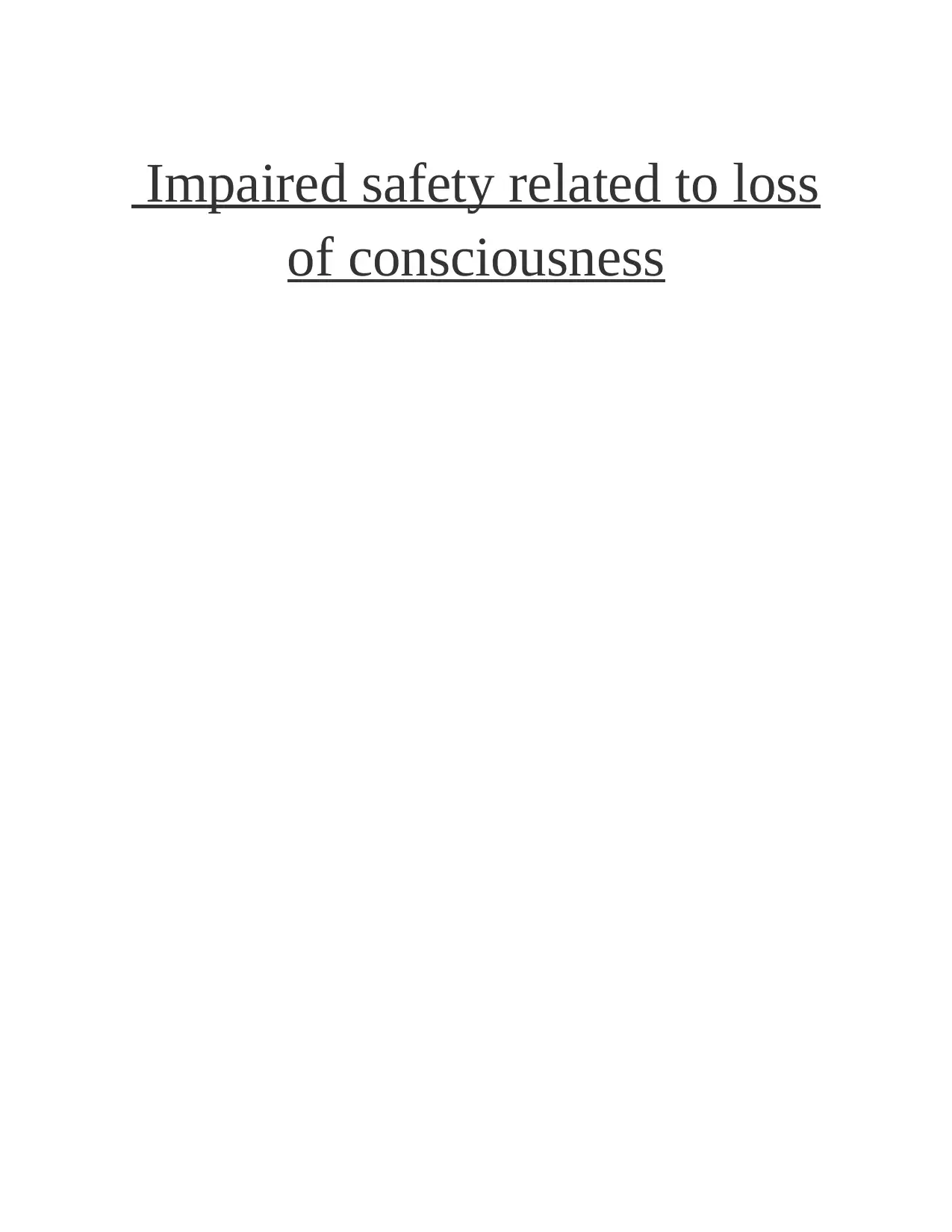
Impaired safety related to loss
of consciousness
of consciousness
Paraphrase This Document
Need a fresh take? Get an instant paraphrase of this document with our AI Paraphraser
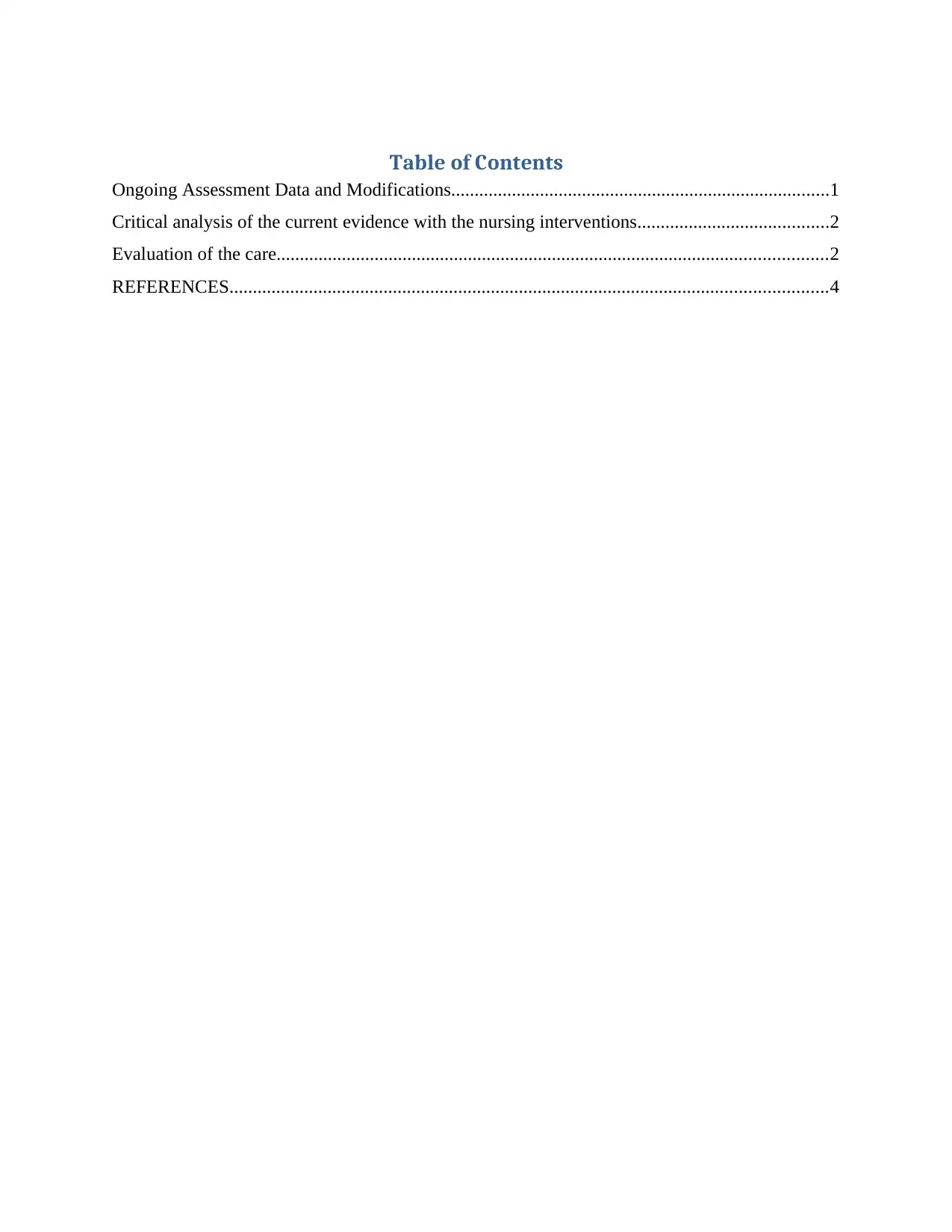
Table of Contents
Ongoing Assessment Data and Modifications.................................................................................1
Critical analysis of the current evidence with the nursing interventions.........................................2
Evaluation of the care......................................................................................................................2
REFERENCES................................................................................................................................4
Ongoing Assessment Data and Modifications.................................................................................1
Critical analysis of the current evidence with the nursing interventions.........................................2
Evaluation of the care......................................................................................................................2
REFERENCES................................................................................................................................4
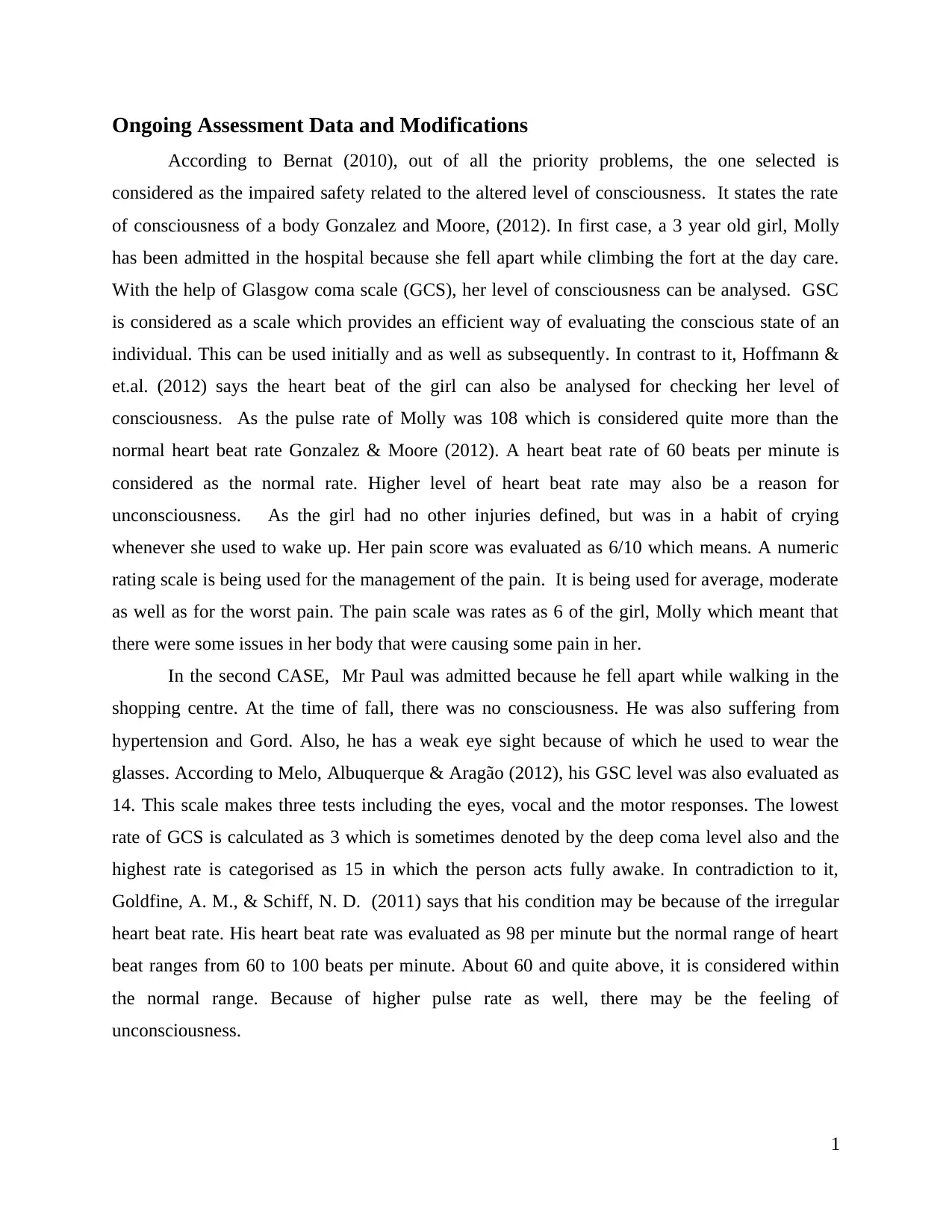
Ongoing Assessment Data and Modifications
According to Bernat (2010), out of all the priority problems, the one selected is
considered as the impaired safety related to the altered level of consciousness. It states the rate
of consciousness of a body Gonzalez and Moore, (2012). In first case, a 3 year old girl, Molly
has been admitted in the hospital because she fell apart while climbing the fort at the day care.
With the help of Glasgow coma scale (GCS), her level of consciousness can be analysed. GSC
is considered as a scale which provides an efficient way of evaluating the conscious state of an
individual. This can be used initially and as well as subsequently. In contrast to it, Hoffmann &
et.al. (2012) says the heart beat of the girl can also be analysed for checking her level of
consciousness. As the pulse rate of Molly was 108 which is considered quite more than the
normal heart beat rate Gonzalez & Moore (2012). A heart beat rate of 60 beats per minute is
considered as the normal rate. Higher level of heart beat rate may also be a reason for
unconsciousness. As the girl had no other injuries defined, but was in a habit of crying
whenever she used to wake up. Her pain score was evaluated as 6/10 which means. A numeric
rating scale is being used for the management of the pain. It is being used for average, moderate
as well as for the worst pain. The pain scale was rates as 6 of the girl, Molly which meant that
there were some issues in her body that were causing some pain in her.
In the second CASE, Mr Paul was admitted because he fell apart while walking in the
shopping centre. At the time of fall, there was no consciousness. He was also suffering from
hypertension and Gord. Also, he has a weak eye sight because of which he used to wear the
glasses. According to Melo, Albuquerque & Aragão (2012), his GSC level was also evaluated as
14. This scale makes three tests including the eyes, vocal and the motor responses. The lowest
rate of GCS is calculated as 3 which is sometimes denoted by the deep coma level also and the
highest rate is categorised as 15 in which the person acts fully awake. In contradiction to it,
Goldfine, A. M., & Schiff, N. D. (2011) says that his condition may be because of the irregular
heart beat rate. His heart beat rate was evaluated as 98 per minute but the normal range of heart
beat ranges from 60 to 100 beats per minute. About 60 and quite above, it is considered within
the normal range. Because of higher pulse rate as well, there may be the feeling of
unconsciousness.
1
According to Bernat (2010), out of all the priority problems, the one selected is
considered as the impaired safety related to the altered level of consciousness. It states the rate
of consciousness of a body Gonzalez and Moore, (2012). In first case, a 3 year old girl, Molly
has been admitted in the hospital because she fell apart while climbing the fort at the day care.
With the help of Glasgow coma scale (GCS), her level of consciousness can be analysed. GSC
is considered as a scale which provides an efficient way of evaluating the conscious state of an
individual. This can be used initially and as well as subsequently. In contrast to it, Hoffmann &
et.al. (2012) says the heart beat of the girl can also be analysed for checking her level of
consciousness. As the pulse rate of Molly was 108 which is considered quite more than the
normal heart beat rate Gonzalez & Moore (2012). A heart beat rate of 60 beats per minute is
considered as the normal rate. Higher level of heart beat rate may also be a reason for
unconsciousness. As the girl had no other injuries defined, but was in a habit of crying
whenever she used to wake up. Her pain score was evaluated as 6/10 which means. A numeric
rating scale is being used for the management of the pain. It is being used for average, moderate
as well as for the worst pain. The pain scale was rates as 6 of the girl, Molly which meant that
there were some issues in her body that were causing some pain in her.
In the second CASE, Mr Paul was admitted because he fell apart while walking in the
shopping centre. At the time of fall, there was no consciousness. He was also suffering from
hypertension and Gord. Also, he has a weak eye sight because of which he used to wear the
glasses. According to Melo, Albuquerque & Aragão (2012), his GSC level was also evaluated as
14. This scale makes three tests including the eyes, vocal and the motor responses. The lowest
rate of GCS is calculated as 3 which is sometimes denoted by the deep coma level also and the
highest rate is categorised as 15 in which the person acts fully awake. In contradiction to it,
Goldfine, A. M., & Schiff, N. D. (2011) says that his condition may be because of the irregular
heart beat rate. His heart beat rate was evaluated as 98 per minute but the normal range of heart
beat ranges from 60 to 100 beats per minute. About 60 and quite above, it is considered within
the normal range. Because of higher pulse rate as well, there may be the feeling of
unconsciousness.
1
⊘ This is a preview!⊘
Do you want full access?
Subscribe today to unlock all pages.

Trusted by 1+ million students worldwide
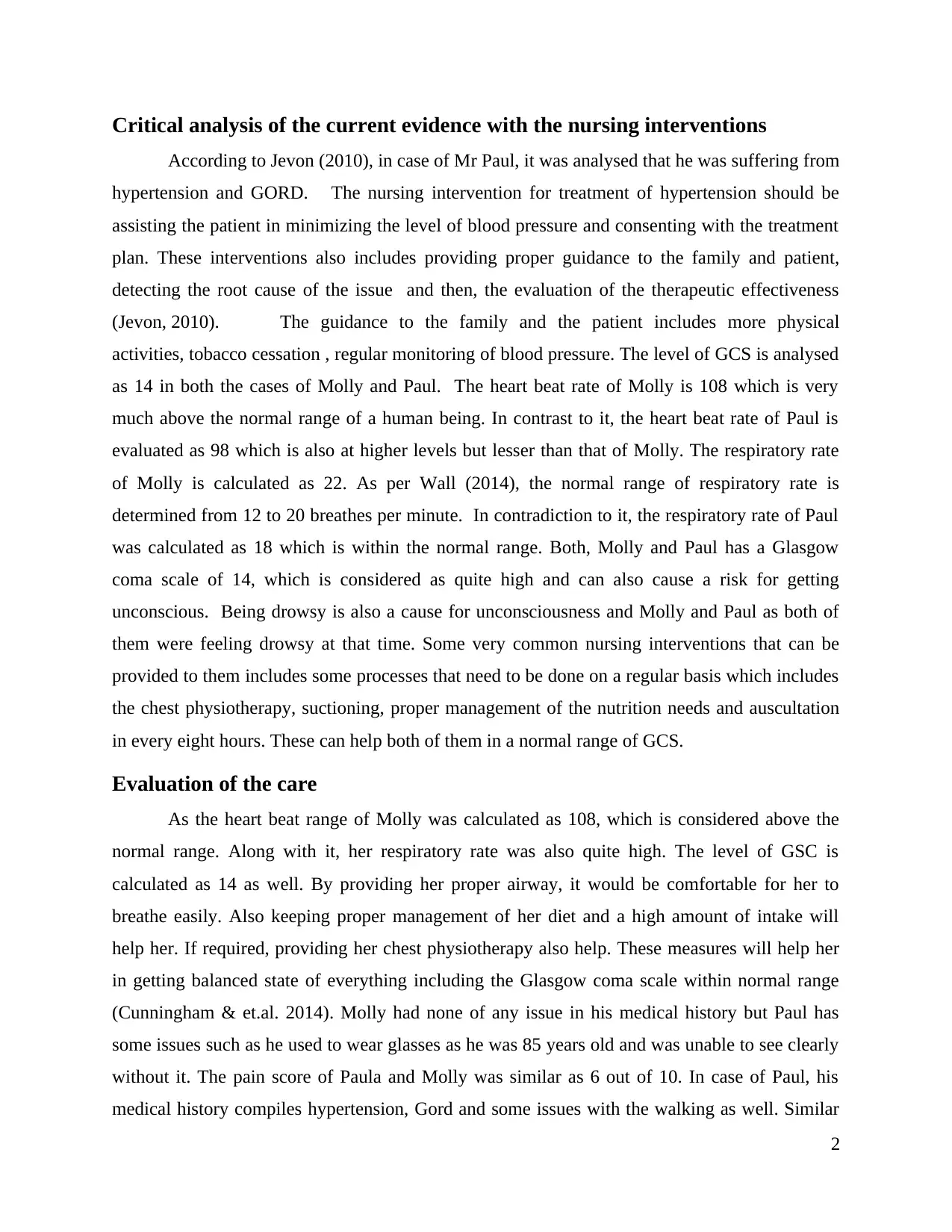
Critical analysis of the current evidence with the nursing interventions
According to Jevon (2010), in case of Mr Paul, it was analysed that he was suffering from
hypertension and GORD. The nursing intervention for treatment of hypertension should be
assisting the patient in minimizing the level of blood pressure and consenting with the treatment
plan. These interventions also includes providing proper guidance to the family and patient,
detecting the root cause of the issue and then, the evaluation of the therapeutic effectiveness
(Jevon, 2010). The guidance to the family and the patient includes more physical
activities, tobacco cessation , regular monitoring of blood pressure. The level of GCS is analysed
as 14 in both the cases of Molly and Paul. The heart beat rate of Molly is 108 which is very
much above the normal range of a human being. In contrast to it, the heart beat rate of Paul is
evaluated as 98 which is also at higher levels but lesser than that of Molly. The respiratory rate
of Molly is calculated as 22. As per Wall (2014), the normal range of respiratory rate is
determined from 12 to 20 breathes per minute. In contradiction to it, the respiratory rate of Paul
was calculated as 18 which is within the normal range. Both, Molly and Paul has a Glasgow
coma scale of 14, which is considered as quite high and can also cause a risk for getting
unconscious. Being drowsy is also a cause for unconsciousness and Molly and Paul as both of
them were feeling drowsy at that time. Some very common nursing interventions that can be
provided to them includes some processes that need to be done on a regular basis which includes
the chest physiotherapy, suctioning, proper management of the nutrition needs and auscultation
in every eight hours. These can help both of them in a normal range of GCS.
Evaluation of the care
As the heart beat range of Molly was calculated as 108, which is considered above the
normal range. Along with it, her respiratory rate was also quite high. The level of GSC is
calculated as 14 as well. By providing her proper airway, it would be comfortable for her to
breathe easily. Also keeping proper management of her diet and a high amount of intake will
help her. If required, providing her chest physiotherapy also help. These measures will help her
in getting balanced state of everything including the Glasgow coma scale within normal range
(Cunningham & et.al. 2014). Molly had none of any issue in his medical history but Paul has
some issues such as he used to wear glasses as he was 85 years old and was unable to see clearly
without it. The pain score of Paula and Molly was similar as 6 out of 10. In case of Paul, his
medical history compiles hypertension, Gord and some issues with the walking as well. Similar
2
According to Jevon (2010), in case of Mr Paul, it was analysed that he was suffering from
hypertension and GORD. The nursing intervention for treatment of hypertension should be
assisting the patient in minimizing the level of blood pressure and consenting with the treatment
plan. These interventions also includes providing proper guidance to the family and patient,
detecting the root cause of the issue and then, the evaluation of the therapeutic effectiveness
(Jevon, 2010). The guidance to the family and the patient includes more physical
activities, tobacco cessation , regular monitoring of blood pressure. The level of GCS is analysed
as 14 in both the cases of Molly and Paul. The heart beat rate of Molly is 108 which is very
much above the normal range of a human being. In contrast to it, the heart beat rate of Paul is
evaluated as 98 which is also at higher levels but lesser than that of Molly. The respiratory rate
of Molly is calculated as 22. As per Wall (2014), the normal range of respiratory rate is
determined from 12 to 20 breathes per minute. In contradiction to it, the respiratory rate of Paul
was calculated as 18 which is within the normal range. Both, Molly and Paul has a Glasgow
coma scale of 14, which is considered as quite high and can also cause a risk for getting
unconscious. Being drowsy is also a cause for unconsciousness and Molly and Paul as both of
them were feeling drowsy at that time. Some very common nursing interventions that can be
provided to them includes some processes that need to be done on a regular basis which includes
the chest physiotherapy, suctioning, proper management of the nutrition needs and auscultation
in every eight hours. These can help both of them in a normal range of GCS.
Evaluation of the care
As the heart beat range of Molly was calculated as 108, which is considered above the
normal range. Along with it, her respiratory rate was also quite high. The level of GSC is
calculated as 14 as well. By providing her proper airway, it would be comfortable for her to
breathe easily. Also keeping proper management of her diet and a high amount of intake will
help her. If required, providing her chest physiotherapy also help. These measures will help her
in getting balanced state of everything including the Glasgow coma scale within normal range
(Cunningham & et.al. 2014). Molly had none of any issue in his medical history but Paul has
some issues such as he used to wear glasses as he was 85 years old and was unable to see clearly
without it. The pain score of Paula and Molly was similar as 6 out of 10. In case of Paul, his
medical history compiles hypertension, Gord and some issues with the walking as well. Similar
2
Paraphrase This Document
Need a fresh take? Get an instant paraphrase of this document with our AI Paraphraser
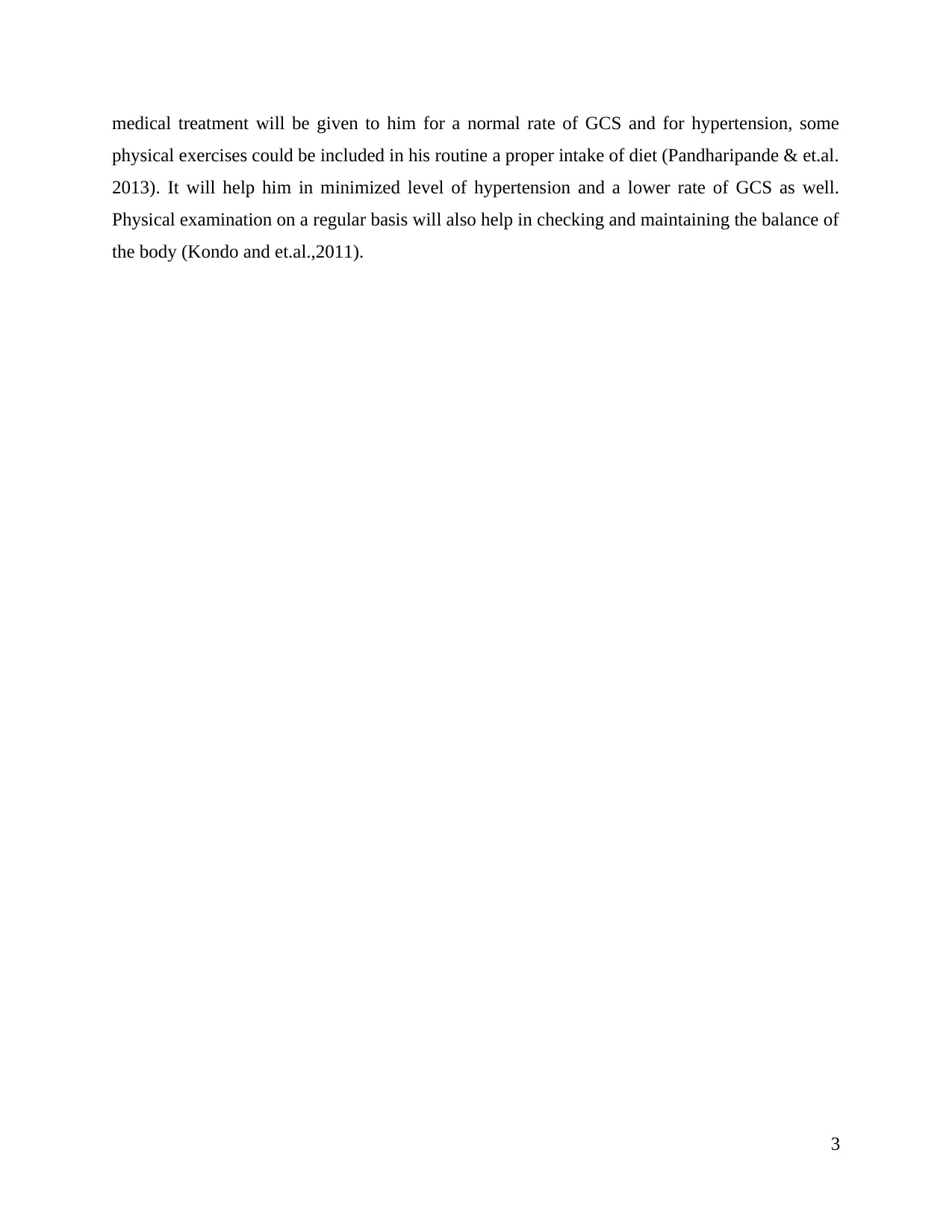
medical treatment will be given to him for a normal rate of GCS and for hypertension, some
physical exercises could be included in his routine a proper intake of diet (Pandharipande & et.al.
2013). It will help him in minimized level of hypertension and a lower rate of GCS as well.
Physical examination on a regular basis will also help in checking and maintaining the balance of
the body (Kondo and et.al.,2011).
3
physical exercises could be included in his routine a proper intake of diet (Pandharipande & et.al.
2013). It will help him in minimized level of hypertension and a lower rate of GCS as well.
Physical examination on a regular basis will also help in checking and maintaining the balance of
the body (Kondo and et.al.,2011).
3
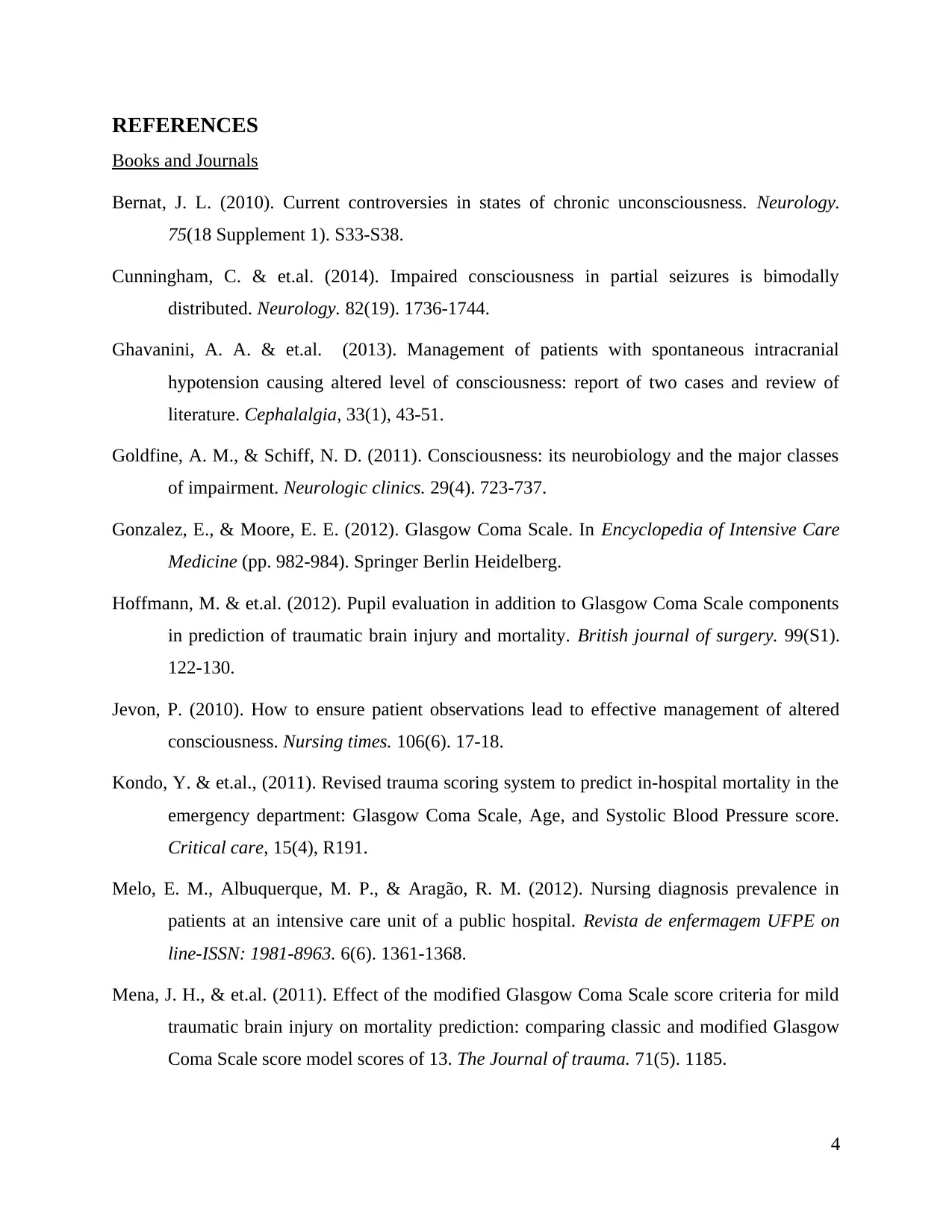
REFERENCES
Books and Journals
Bernat, J. L. (2010). Current controversies in states of chronic unconsciousness. Neurology.
75(18 Supplement 1). S33-S38.
Cunningham, C. & et.al. (2014). Impaired consciousness in partial seizures is bimodally
distributed. Neurology. 82(19). 1736-1744.
Ghavanini, A. A. & et.al. (2013). Management of patients with spontaneous intracranial
hypotension causing altered level of consciousness: report of two cases and review of
literature. Cephalalgia, 33(1), 43-51.
Goldfine, A. M., & Schiff, N. D. (2011). Consciousness: its neurobiology and the major classes
of impairment. Neurologic clinics. 29(4). 723-737.
Gonzalez, E., & Moore, E. E. (2012). Glasgow Coma Scale. In Encyclopedia of Intensive Care
Medicine (pp. 982-984). Springer Berlin Heidelberg.
Hoffmann, M. & et.al. (2012). Pupil evaluation in addition to Glasgow Coma Scale components
in prediction of traumatic brain injury and mortality. British journal of surgery. 99(S1).
122-130.
Jevon, P. (2010). How to ensure patient observations lead to effective management of altered
consciousness. Nursing times. 106(6). 17-18.
Kondo, Y. & et.al., (2011). Revised trauma scoring system to predict in-hospital mortality in the
emergency department: Glasgow Coma Scale, Age, and Systolic Blood Pressure score.
Critical care, 15(4), R191.
Melo, E. M., Albuquerque, M. P., & Aragão, R. M. (2012). Nursing diagnosis prevalence in
patients at an intensive care unit of a public hospital. Revista de enfermagem UFPE on
line-ISSN: 1981-8963. 6(6). 1361-1368.
Mena, J. H., & et.al. (2011). Effect of the modified Glasgow Coma Scale score criteria for mild
traumatic brain injury on mortality prediction: comparing classic and modified Glasgow
Coma Scale score model scores of 13. The Journal of trauma. 71(5). 1185.
4
Books and Journals
Bernat, J. L. (2010). Current controversies in states of chronic unconsciousness. Neurology.
75(18 Supplement 1). S33-S38.
Cunningham, C. & et.al. (2014). Impaired consciousness in partial seizures is bimodally
distributed. Neurology. 82(19). 1736-1744.
Ghavanini, A. A. & et.al. (2013). Management of patients with spontaneous intracranial
hypotension causing altered level of consciousness: report of two cases and review of
literature. Cephalalgia, 33(1), 43-51.
Goldfine, A. M., & Schiff, N. D. (2011). Consciousness: its neurobiology and the major classes
of impairment. Neurologic clinics. 29(4). 723-737.
Gonzalez, E., & Moore, E. E. (2012). Glasgow Coma Scale. In Encyclopedia of Intensive Care
Medicine (pp. 982-984). Springer Berlin Heidelberg.
Hoffmann, M. & et.al. (2012). Pupil evaluation in addition to Glasgow Coma Scale components
in prediction of traumatic brain injury and mortality. British journal of surgery. 99(S1).
122-130.
Jevon, P. (2010). How to ensure patient observations lead to effective management of altered
consciousness. Nursing times. 106(6). 17-18.
Kondo, Y. & et.al., (2011). Revised trauma scoring system to predict in-hospital mortality in the
emergency department: Glasgow Coma Scale, Age, and Systolic Blood Pressure score.
Critical care, 15(4), R191.
Melo, E. M., Albuquerque, M. P., & Aragão, R. M. (2012). Nursing diagnosis prevalence in
patients at an intensive care unit of a public hospital. Revista de enfermagem UFPE on
line-ISSN: 1981-8963. 6(6). 1361-1368.
Mena, J. H., & et.al. (2011). Effect of the modified Glasgow Coma Scale score criteria for mild
traumatic brain injury on mortality prediction: comparing classic and modified Glasgow
Coma Scale score model scores of 13. The Journal of trauma. 71(5). 1185.
4
⊘ This is a preview!⊘
Do you want full access?
Subscribe today to unlock all pages.

Trusted by 1+ million students worldwide
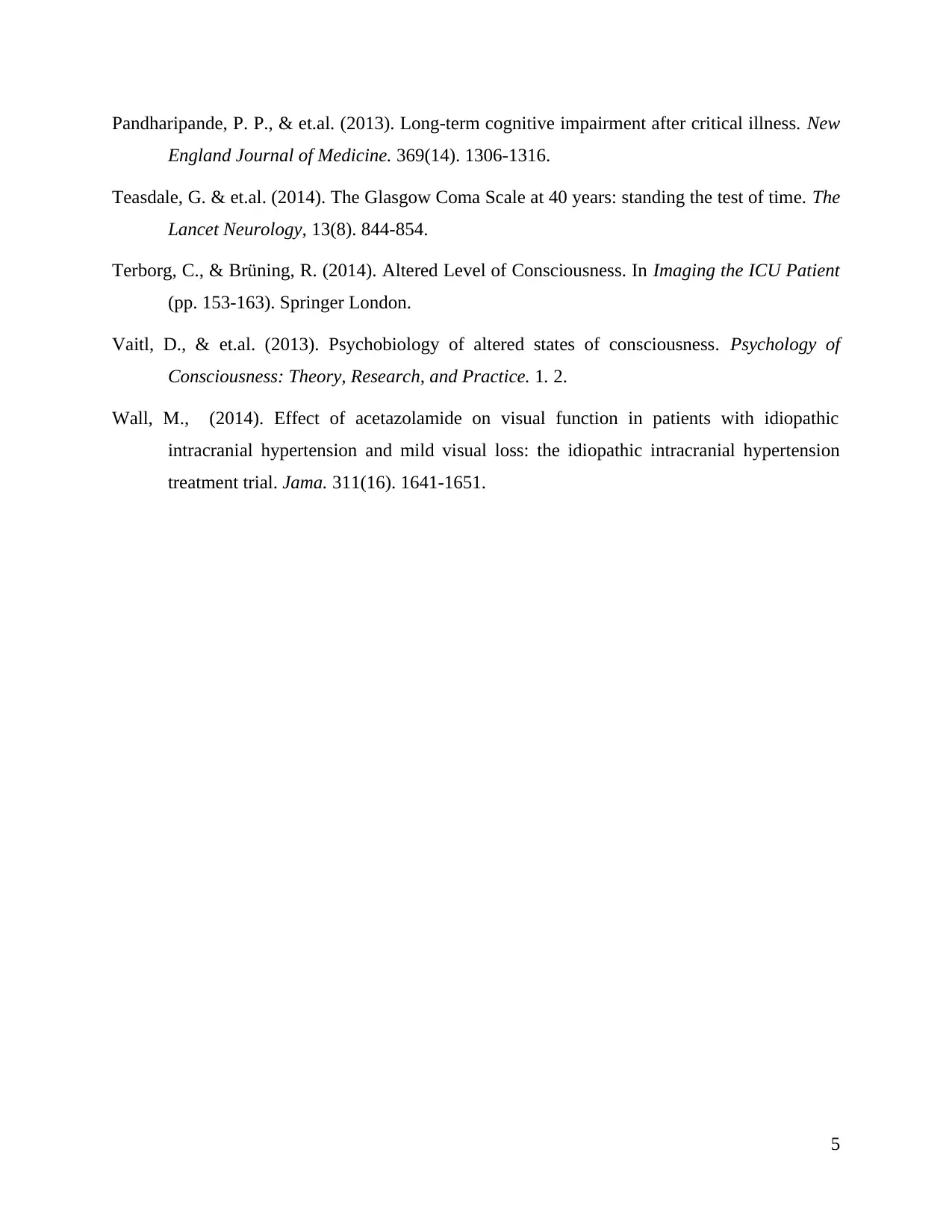
Pandharipande, P. P., & et.al. (2013). Long-term cognitive impairment after critical illness. New
England Journal of Medicine. 369(14). 1306-1316.
Teasdale, G. & et.al. (2014). The Glasgow Coma Scale at 40 years: standing the test of time. The
Lancet Neurology, 13(8). 844-854.
Terborg, C., & Brüning, R. (2014). Altered Level of Consciousness. In Imaging the ICU Patient
(pp. 153-163). Springer London.
Vaitl, D., & et.al. (2013). Psychobiology of altered states of consciousness. Psychology of
Consciousness: Theory, Research, and Practice. 1. 2.
Wall, M., (2014). Effect of acetazolamide on visual function in patients with idiopathic
intracranial hypertension and mild visual loss: the idiopathic intracranial hypertension
treatment trial. Jama. 311(16). 1641-1651.
5
England Journal of Medicine. 369(14). 1306-1316.
Teasdale, G. & et.al. (2014). The Glasgow Coma Scale at 40 years: standing the test of time. The
Lancet Neurology, 13(8). 844-854.
Terborg, C., & Brüning, R. (2014). Altered Level of Consciousness. In Imaging the ICU Patient
(pp. 153-163). Springer London.
Vaitl, D., & et.al. (2013). Psychobiology of altered states of consciousness. Psychology of
Consciousness: Theory, Research, and Practice. 1. 2.
Wall, M., (2014). Effect of acetazolamide on visual function in patients with idiopathic
intracranial hypertension and mild visual loss: the idiopathic intracranial hypertension
treatment trial. Jama. 311(16). 1641-1651.
5
1 out of 7
Related Documents
Your All-in-One AI-Powered Toolkit for Academic Success.
+13062052269
info@desklib.com
Available 24*7 on WhatsApp / Email
![[object Object]](/_next/static/media/star-bottom.7253800d.svg)
Unlock your academic potential
Copyright © 2020–2025 A2Z Services. All Rights Reserved. Developed and managed by ZUCOL.





